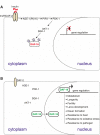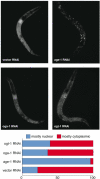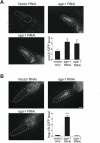Intracellular protein glycosylation modulates insulin mediated lifespan in C.elegans
- PMID: 20952811
- PMCID: PMC2993798
- DOI: 10.18632/aging.100208
Intracellular protein glycosylation modulates insulin mediated lifespan in C.elegans
Abstract
O-linked-β-N-acetylglucosamine (O-GlcNAc) modification is a regulatory, nuclear and cytoplasmic post-translational glycosylation of proteins associated with age-related diseases such as Alzheimer's, Parkinson's, and type II diabetes. Global elevation of O-GlcNAc levels on intracellular proteins can induce insulin resistance, the hallmark of type II diabetes, in mammalian systems. InC. elegans, attenuation of the insulin-like signal transduction pathway increases adult lifespan of the nematode. We demonstrate that the O-GlcNAc cycling enzymes OGT and OGA, which add and remove O-GlcNAc respectively, modulate lifespan in C. elegans. Median adult lifespan is increased in an oga-1 deletion strain while median adult life span is decreased upon ogt-1 deletion. The O-GlcNAc-mediated effect on nematode lifespan is dependent on the FoxO transcription factor DAF-16. DAF-16 is a key factor in the insulin-like signal transduction pathway to regulate reproductive development, lifespan, stress tolerance, and dauer formation in C. elegans. Our data indicates that O-GlcNAc cycling selectively influences only a subset of DAF-16 mediated phenotypes, including lifespan and oxidative stress resistance. We performed an affinity purification of O-GlcNAc-modified proteins and observed that a high percentage of these proteins are regulated by insulin signaling and/or impact insulin pathway functional outcomes, suggesting that the O-GlcNAc modification may control downstream effectors to modulate insulin pathway mediated cellular processes.
Conflict of interest statement
The authors of this manuscript have no conflict of interests to declare.
Figures






Comment in
-
O-GlcNAc and aging: C. elegans as a genetic model to test O-GlcNAc roles in type II diabetic insulin resistance.Aging (Albany NY). 2010 Nov;2(11):749-51. doi: 10.18632/aging.100225. Aging (Albany NY). 2010. PMID: 21068466 Free PMC article. No abstract available.
References
-
- Biddinger SB, Kahn CR. From mice to men: insights into the insulin resistance syndromes. Annual review of physiology. 2006;68:123–158. - PubMed
-
- Marshall S, Bacote V, Traxinger RR. Discovery of a metabolic pathway mediating glucose-induced desensitization of the glucose transport system. Role of hexosamine biosynthesis in the induction of insulin resistance. The Journal of biological chemistry. 1991;266:4706–4712. - PubMed
-
- Wells L, Vosseller K, Hart GW. Glycosylation of nucleocytoplasmic proteins: signal transduction and O-GlcNAc. Science. 2001;291:2376–2378. - PubMed
-
- Hart GW, Housley MP, Slawson C. Cycling of O-linked beta-N-acetylglucosamine on nucleocytoplasmic proteins. Nature. 2007;446:1017–1022. - PubMed
-
- Dias WB, Hart GW. O-GlcNAc modification in diabetes and Alzheimer's disease. Mol Biosyst. 2007;3:766–772. - PubMed
Publication types
MeSH terms
Substances
Grants and funding
LinkOut - more resources
Full Text Sources
Medical
Miscellaneous

